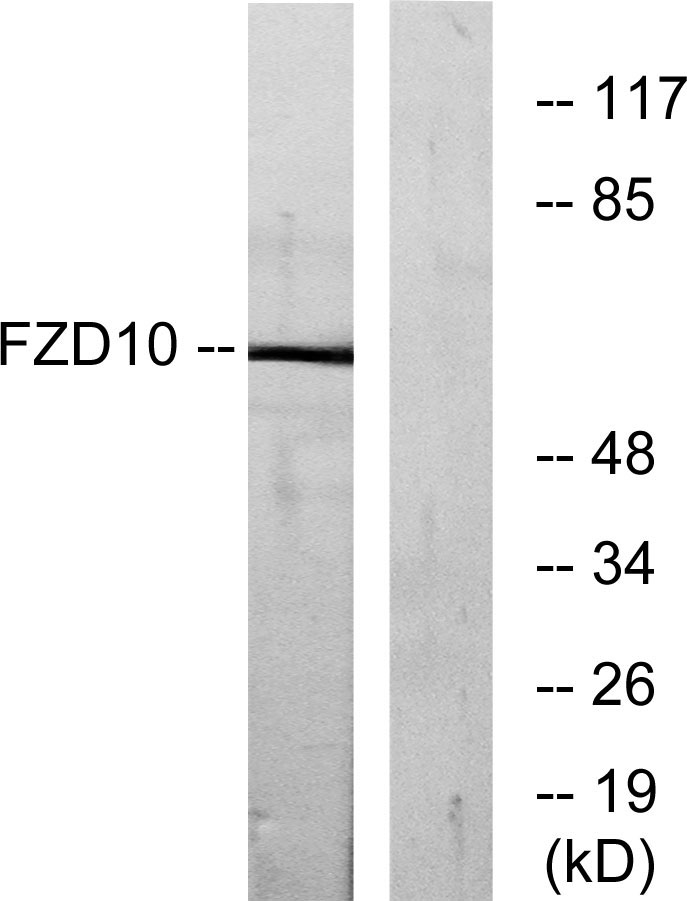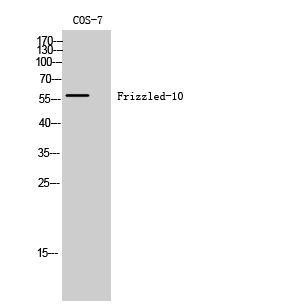产品名称
Frizzled-10 Rabbit Polyclonal Antibody
别名
FZD10; Frizzled-10; Fz-10; hFz10; FzE7; CD antigen CD350
存储缓冲液
Liquid in PBS containing 50% glycerol, 0.5% BSA and 0.02% New type preservative N.
Human Gene Link
http://www.ncbi.nlm.nih.gov/sites/entrez?db=gene&term=11211
Human Swissprot No.
Q9ULW2
Human Swissprot Link
http://www.uniprot.org/uniprotkb/Q9ULW2/entry
Mouse Gene Link
http://www.ncbi.nlm.nih.gov/sites/entrez?db=gene&term=93897
Mouse Swissprot No.
Q8BKG4
Mouse Swissprot Link
http://www.uniprot.org/uniprot/Q8BKG4
免疫原
The antiserum was produced against synthesized peptide derived from human FZD10. AA range:135-184
特异性
Frizzled-10 Polyclonal Antibody detects endogenous levels of Frizzled-10 protein.
稀释度
WB 1:500 - 1:2000. IHC 1:100 - 1:300. IF 1:200 - 1:1000. ELISA: 1:5000. Not yet tested in other applications.
宿主
Polyclonal, Rabbit,IgG
背景介绍
This gene is a member of the frizzled gene family. Members of this family encode 7-transmembrane domain proteins that are receptors for the Wingless type MMTV integration site family of signaling proteins. Most frizzled receptors are coupled to the beta-catenin canonical signaling pathway. Using array analysis, expression of this intronless gene is significantly up-regulated in two cases of primary colon cancer. [provided by RefSeq, Jul 2008],
组织表达
Highest levels in the placenta and fetal kidney, followed by fetal lung and brain. In adult brain, abundantly expressed in the cerebellum, followed by cerebral cortex, medulla and spinal cord; very low levels in total brain, frontal lobe, temporal lobe and putamen. Weak expression detected in adult brain, heart, lung, skeletal muscle, pancreas, spleen and prostate.
细胞定位
Cell membrane ; Multi-pass membrane protein .
信号通路
WNT;WNT-T CELLMelanogenesis;Pathways in cancer;Colorectal cancer;Basal cell carcinoma;
功能
domain:Lys-Thr-X-X-X-Trp motif is involved in the activation of the Wnt/beta-catenin signaling pathway.,domain:The FZ domain is involved in binding with Wnt ligands.,function:Receptor for Wnt proteins. Most of frizzled receptors are coupled to the beta-catenin canonical signaling pathway, which leads to the activation of disheveled proteins, inhibition of GSK-3 kinase, nuclear accumulation of beta-catenin and activation of Wnt target genes. A second signaling pathway involving PKC and calcium fluxes has been seen for some family members, but it is not yet clear if it represents a distinct pathway or if it can be integrated in the canonical pathway, as PKC seems to be required for Wnt-mediated inactivation of GSK-3 kinase. Both pathways seem to involve interactions with G-proteins. May be involved in transduction and intercellular transmission of polarity information during tissue morphogenesis and/or in differentiated tissues.,similarity:Belongs to the G-protein coupled receptor Fz/Smo family.,similarity:Contains 1 FZ (frizzled) domain.,tissue specificity:Highest levels in the placenta and fetal kidney, followed by fetal lung and brain. In adult brain, abundantly expressed in the cerebellum, followed by cerebral cortex, medulla and spinal cord; very low levels in total brain, frontal lobe, temporal lobe and putamen. Weak expression detected in adult brain, heart, lung, skeletal muscle, pancreas, spleen and prostate.,
纯化
The antibody was affinity-purified from rabbit antiserum by affinity-chromatography using epitope-specific immunogen.


